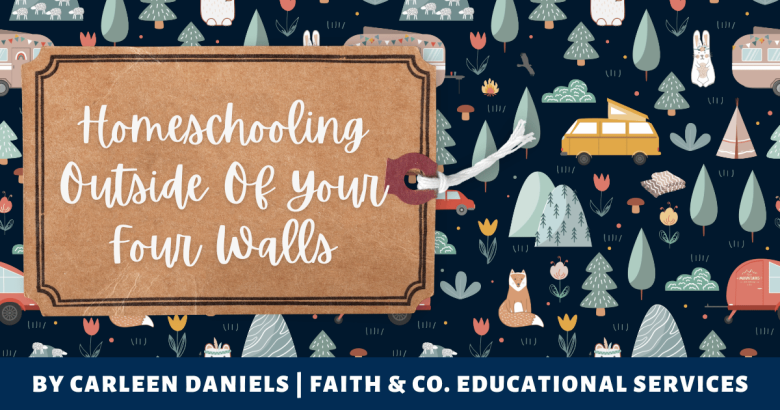-
This post is sponsored by Lone Star Homeschool Academy. Get your 14-day FREE trial!
By Carleen Daniels | Faith & Co. Educational Services
When many people hear the word homeschool they think of school at home - that when a family decides to homeschool, they are trapped inside the four walls of their home.
Well, this is not always true.
Solving Socialization Issues
One of the biggest hurdles that home-educated families need to overcome is socialization.
Thinking outside the box will allow families to open up a world of possibilities and opportunities that can solve this issue.
Families that learn at home do not have to be confined to their homes for learning to occur.
Just like how homeschool parents have the choice of what to teach, they can choose where learning can take place as well.
Homeschooling is not just school at home. It is a way of learning with freedom and the act of selecting or making decisions when faced with possibilities.
It allows families the option to school how they want, when they want, and where they want. This is a circumstance that many parents do not even realize is available.
A Good Option
Homeschooling is a whole different approach to education, and not all the learning has to take place inside the four walls of your house.
Most parents choose to homeschool because they want to give their children opportunities and freedoms that they're not allowed in public schools.
Educating children through homeschooling can actually occur in many places, not just at home! Learning can be tailored around the places you journey.
Every trip outside your home can turn into a learning experience. You can join others in learning when venturing out to learn.
Select opportunities that expand on current lessons or units that you are teaching and topics you are learning.
Learning outside your home typically involves taking your educational activities and lessons to various locations, such as libraries, museums, parks, or community centers.
The possibilities are truly limitless and differ for each family and their experiences or needs.
You can adapt your curriculum to make use of the resources available in these settings and create a more experiential learning environment.
Field trips, group activities, and engaging with the local community can all be incorporated into your homeschooling approach outside your home.
Some of these things could never happen inside your house, however, this is still considered homeschooling.
These adventures can be a wonderful way to energize your kids and renew the love of learning that they may have lost.
While learning at home inside has its benefits and needs, when you take learning outside the home, outside your four walls, and you think outside the box - that is when true learning can really take off and can be most effective for certain students.
If your children (or you) are having issues with focusing on schoolwork because of distractions at home, you may want to open up your classroom to opportunities outside your house.
The world is our home, so class is always in session when we take things outside the home.
How to Have a Successful Experience
When deciding to homeschool outside the house, planning is not necessary but can be helpful. To ensure that it is a successful experience, be sure that you have everything you need to accomplish the lesson if it is pre-planned.
You will want to have any materials you need for teaching and learning if you are leading a planned lesson, such as workbooks and writing supplies.
It might be helpful to have a kit of things ready to go or a bag with things packed for your journeys out and about that house general supplies such as paper, pencils, crayons, and other materials that may come in handy in the spur-of-the-moment.
Younger children: To avoid meltdowns and make these trips economical, you may want to pack water and snacks, especially for younger children.
You can use lists that have pictures and words so that they can pack their own supplies they will need. Older children can help them locate items and pack.
Older children: You can involve older children by giving them a list of items they need for the adventure. Have the kids pack all of their supplies or materials they will need to be successful.
Hold a discussion and allow them to be a part of the decision-making process of where to go. Older learners love to be given the opportunity to make choices!
Some families like to designate a certain day of the week to go out and about to do learning. You can choose to do it once a month as a reward, such as fun Friday activities where the kids can choose where they want to go from a list of options or plan a time each day or on a specific day of the week when you go in the backyard at your house for a change of scenery.
This might be a reading lesson under a large, shady tree, or perhaps you have a science experiment planned that may get messy.
You can create an outdoor workspace as a family for messy crafts and science experiments, or anything messy to be done outside.
This is a great way to change scenery to see if it is a good option for your family and still not need to actually go anywhere!
Where to Start
There are many different ways to make a fun and memorable experience for your kids. You don't have to do it every week and it does not need to cost money!
You can start by holding a lesson in your own backyard or neighborhood. If that goes well, go to the park. Or jump right in and go! There really is no wrong way to start!
Families can homeschool outside their homes by utilizing various strategies and resources.
1. Local businesses: Turn those everyday essential trips to places like the grocery store, restaurants, the bank, a doctor’s office, or a veterinarian clinic into learning opportunities.
These are great opportunities for children to ask questions and develop real-world skills. You can design a lesson for these outings or allow for impromptu learning experiences.
Another option might be to go to a favorite spot for lunch and bring your lesson with you. If you choose a restaurant, you can work while you wait for your food to come to the table.
2. Field Trips: Plan educational outings to museums, zoos, historical sites, science centers, botanical gardens, and other places of interest. These trips provide real-world learning experiences.
3. Library Visits: Regularly visit the library for reading sessions, research, and access educational materials. Many libraries also offer workshops and events for homeschoolers.
Select a day during the week to go to the library and have a work day there. Many public libraries have study rooms available to reserve.
4. Outdoor Learning: Take advantage of your backyard, local parks, local farms, nature reserves, and outdoor spaces for hands-on science, nature study, physical education, and recreational activities.
These outings provide opportunities to connect with nature: Plan to have a picnic at the park to fit in playtime and learning as well.
5. Community Classes: Enroll in community classes, workshops, or sports leagues. Many local organizations offer programs tailored for homeschoolers.
6. Co-op Groups: Join or create homeschooling co-operative (co-op) groups where families share teaching responsibilities, resources, and expertise in various subjects.
7. Online Resources: Utilize online educational platforms, virtual classes, and educational websites to supplement your curriculum when outside the home.
8. Cultural Experiences: Attend cultural events, art galleries, theater performances, and music concerts to enhance arts and cultural education.
9. Volunteer Work: Engage in volunteer activities as a family, allowing children to learn valuable life skills and contribute to their community.
10. Travel: Incorporate educational trips and travel experiences as part of your homeschooling.
Learning about different cultures, geography, and history through travel can be enriching. The car, RV, or vacation destinations can be turned into a classroom.
11. Local Experts: Invite guest speakers or local experts to give talks or workshops on specific subjects of interest.
12. Hands-On Learning: Engage in practical learning experiences, such as cooking, gardening, woodworking, and crafting, to teach valuable life skills.
13. Socialization: Organize play dates, group activities, and meetups with other homeschooling families to provide social interaction and networking opportunities.
Some lessons are just better suited for the home, while others may be perfect for somewhere else.
Remember, the key is to be flexible, adaptable, and creative in designing your homeschooling approach outside your home.
Whether it is going to the park or just venturing out into the backyard, the world is your classroom! Just like homeschooling, learning outside your four walls can be an adventure!
Read More!
- Log in to post comments






